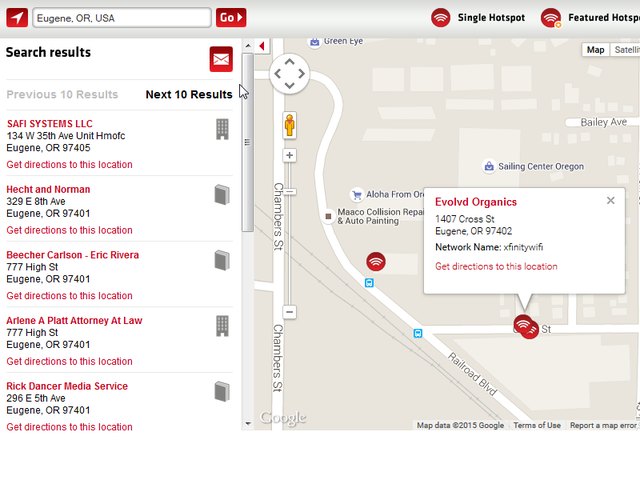Chances are you have a Wi-Fi
network at home, or live close to one (or more) that tantalizingly pop
up in a list whenever you boot up the laptop. The problem is, if there's
a lock next to the name, that indicates security for the Wi-Fi network
is turned on. Without the password or passphrase, you're not going to
get access to that network, or that sweet, sweet Internet that goes with
it.
Perhaps you forgot the password on your own network, or don't have
neighbors willing to share the Wi-Fi goodness. You could just go to a
café and buy a latte and use the "free" Wi-Fi there. Download an app for
your phone like
WiFi-Map, and
you'll have a list of over 2 million hotspots with free Wi-Fi for the
taking (including some passwords for locked Wi-Fi connections, if
they're shared by any of the app's 7 million users).
But there are other ways to get back on the wireless, though some of
them require such extreme patience and waiting, that café idea is going
to look pretty good.
Reset the Router
Before you do this, just try to log into the router first. From
there, you can easily reset your wireless password if you've forgotten
it.
The problem is when you don't know the password for the router,
either. (They're not the same thing, unless you set it up that way).
Resetting the router is about as brute force a method as you get, and it
only works if you have physical access to the router.
Almost every router in existence has a recessed reset button it. Push
it with a pen or unfolded paperclip, hold it for about 10 seconds, and
the router will change to the factory settings.

If you've got a router that came from your Internet service provider,
check the stickers before a reset—they might have printed the router
and Wi-Fi passwords (sometimes called the
key) right on the hardware.
Once it's reset, you need another password (plus a username) to
access the router itself. Generally you can do this in a Web browser of
any PC attached to the router via Ethernet—you'll need that since the
reset probably killed any potential Wi-Fi connection you had going in.
The URL to type is either 192.168.1.1 or 192.168.0.1, or some
variation. Once you're asked for a username/password, what do you do?
Check your manual. Which you probably lost or threw away. So instead, go
to
RouterPasswords.com. The site exists for one reason: to tell people the default username/password on just about every router ever created.

You'll need the router's model number, but that's easy enough to find
on the back or bottom. You'll quickly see a pattern among router makers
of having the username of
admin and a password of
password.
Since most people are lazy and don't change an assigned password, you
could try it before hitting the reset button. (But c'mon, you're better
than that—change the password once you're in the router's menus in your
Web browser.)
Once you've accessed the router interface, go to the Wi-Fi settings,
turn on the wireless networks, and assign them strong but easy-to-recall
passwords. After all, you don't want to share with neighbors without
your permission.
Crack the Code
You didn't come here because the headline said "reset the router,"
though. You want to know how to crack the password on a Wi-Fi network.
Searching on "wi-fi password hack," or other variations, nets you a
lot of links—mostly for software on sites where the adware and bots and
scams are pouring like snake oil. Download them at your own risk, for
Windows PCs especially. Better to have a PC that you can afford to get
effed up a bit if you go that route. I had multiple attempts with tools I
found just get outright deleted by my antivirus before I could even try
to run the EXE installation file.
Or, create a system just for this kind of thing, maybe dual-boot into
a separate operating system that can do what's called "penetration
testing"—a form of offensive approach security, where you examine a
network for any and all possible paths of breach.
Kali Linux is
a Linux distribution built for just that purpose. You can run Kali
Linux off a CD or USB key without even installing it to the hard drive.
Another option is
BackTrack Linux—they're
actually both from the same developers, but Kali is the "polished"
version. Both are free and come with all the tools you'd need to crack a
network.

If you don't want to install a whole OS, then you could try the two tried-and-true tools of Wi-Fi hackers.
Aircrack has been around for years, going back to when Wi-Fi security
was only based on WEP (Wired Equivalent Privacy). WEP was weak even
back in the day, and was supplanted in 2004 by WPA (Wi-Fi Protected
Access). The latest
Aircrack-ng 1.2—labeled
as a "set of tools for auditing wireless networks," so it should be
part of any network admin's toolkit—will take on cracking WEP and
WPA-PSK keys.
Aircrack-ng comes with full documentation, but it's not going to be
that simple. To crack a network you also need to have the right kind of
Wi-Fi adapter in your computer, one that supports packet injection. You
need to be comfortable with the command line (running things using CMD)
and have a lot of patience. Your Wi-Fi adapter and Aircrack have to
gather a lot of data to get anywhere close to decrypting the passkey on
the network you're targeting. It could take a while.
If you prefer a graphical user interface (GUI), there is KisMAC-ng, or there was.
The website was
not working as of the writing of this article. While KisMAC can crack
some keys with the right adapter installed, it's mainly known as a
"sniffer" for seeking out Wi-Fi networks. It's the kind of thing we
don't need much of these days, since our phones and tablets do a pretty
good job of showing us every since Wi-Fi signal in the air around us.
Also on the Mac:
Wi-Fi Crack. To use them or Aircrack-ng on the Mac, you need to install them using
MacPorts, a tool for installing command-line products on the Mac.

Cracking stronger WPA/WPA2 passwords and passphrases is the real trick these days.
Reaver is
the one tool that looks to be up to the task (and it's part of the
BackTrack Linux distro). You'll need that command-line comfort again to
work with it, or you'll have to spend
$65 for Reaver Pro, a
hardware device that works with Windows and Mac. After two to 10 hours
of trying brute force attacks, Reaver should be able to reveal a
password... but it's only going to work if the router you're going after
has both a strong signal and WPS (Wi-Fi Protected Setup) turned on. WPS
is the feature where you can push a button on router, another button on
a Wi-Fi device, and they find each other and link auto-magically, with a
fully encrypted connection. It's also the "hole" through which Reaver
crawls. It can generally break the code in about 24 hours.
Even if you turn off WPS, sometimes it's not completely off, but
that's your only recourse if you're worried about hacks on your own
router. Or, get a router that doesn't support WPS.








































